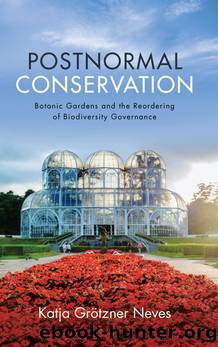Postnormal Conservation: Botanic Gardens and the Reordering of Biodiversity Governance by Katja Grotzner Neves

Author:Katja Grotzner Neves [Neves, Katja Grotzner]
Language: eng
Format: epub
Tags: Public Policy, Environmental Policy, Political Science
ISBN: 9781438474557
Google: jLKZDwAAQBAJ
Goodreads: 43505735
Publisher: SUNY Press
Published: 2019-06-01T00:00:00+00:00
3.3 A âFirst Point of Contact with Natureâ: Relational Monarch Ontologies of Conservation
The morning of February 28, 2018, started as mornings often do in Montreal at that time of the year: gray and windy. The heart-warming effect of the cityâs snow-covered landscape had just given way to an endless sea of pebble-covered sidewalks. This is a normal occurrence in Montreal, when snowfall is followed by gloriously sunnyâthough frigidâweather: the cityâs sidewalks turn into treacherous ice paths that no amount of salt can effectively prevent. Excepting the outdoorsy folk who were enjoying winter offerings like Old Montrealâs skating rink or Mont Royalâs forested trails, most people seemed to have retreated to the coziness of cafés, pubs, underground shops, and workplaces. With thermometers hovering around the zero Celsius mark (32-degrees Fahrenheit), the temperature had been higher than usual for end of February. Still, somehow, the intermittent freezing rain that had settled in felt worse to bear than one might recall of Montrealâs diurnal end-of-February average of â7-degrees Celsius (19.4-degrees Fahrenheit).
I felt particularly grateful for being able to conduct research not only on but also at institutions like the Jardin Botanique Montréal (Montreal Botanical Gardens) and the Montréal Insectariumâtwo of the institutions that comprise Espace Pour la Vie/Space for Life (EPLV) together with the Biodôme Montréal and the Planetarium Rio Tinto Alcan Montréal. Setting aside any romantic notions that may be associated with the warmth of lush tropical greenhouses and mesmerizing vivariums during winter, botanic gardens and kin institutions are fascinating sites for social-scientific research. The breath of the historical legacies of these institutions with their roles in the rise of modernity, the nation-state, and empire building is bewildering. Their histories within processes of postcolonial struggle are equally inordinateâas is their current reinvention all around the world into institutions of environmental research and practice.
As highly visible constituencies in the production and dissemination of monarch conservation knowledge, institutions like the Insectarium Montréal and the Jardin Botanique Montréal (as well as EPLV, more generally), hold great responsibility over the conceptualization and representation of contemporary environmental problems. On that particular day, I was especially looking forward to begin a series of interviews about the research, education, and public outreach initiatives that Espace Pour la Vie/Space for Life (EPLV) had developed and implemented over the years in reaction to the monarch butterflyâs plight. Thanks to the generous support of Anne Bruneau, a colleague at the Quebec Center for Biodiversity Science, I had been granted meetings in February and March with Dr. Maxim Larrivée, director of EPLVâs Insectarium Entomological Collections and Research; Sonya Charest, education program officer and former coordinator of Monarchs without Frontiers; and Andre-Philippe Drapeau Picard,46 Mission Monarch coordinator. It was a follow-up to research I had conducted in previous years at the Jardin Botanique Montréal regarding its collaborative role in promoting monarch conservation within EPLV.
My goal was to collect additional data to illustrate three intersecting axes of change in biodiversity conservation, which I had identified in the course of my research at botanical gardens, and, which first motivated me to write Postnormal Conservation.
Download
This site does not store any files on its server. We only index and link to content provided by other sites. Please contact the content providers to delete copyright contents if any and email us, we'll remove relevant links or contents immediately.
Sapiens: A Brief History of Humankind by Yuval Noah Harari(14252)
The Tidewater Tales by John Barth(12608)
Mastermind: How to Think Like Sherlock Holmes by Maria Konnikova(7227)
Do No Harm Stories of Life, Death and Brain Surgery by Henry Marsh(6891)
The Thirst by Nesbo Jo(6828)
Why We Sleep: Unlocking the Power of Sleep and Dreams by Matthew Walker(6618)
Life 3.0: Being Human in the Age of Artificial Intelligence by Tegmark Max(5474)
Sapiens by Yuval Noah Harari(5294)
The Longevity Diet by Valter Longo(5021)
The Body: A Guide for Occupants by Bill Bryson(4974)
The Rules Do Not Apply by Ariel Levy(4861)
The Immortal Life of Henrietta Lacks by Rebecca Skloot(4525)
Animal Frequency by Melissa Alvarez(4395)
Why We Sleep by Matthew Walker(4360)
The Hacking of the American Mind by Robert H. Lustig(4318)
Yoga Anatomy by Kaminoff Leslie(4306)
All Creatures Great and Small by James Herriot(4233)
Double Down (Diary of a Wimpy Kid Book 11) by Jeff Kinney(4207)
Barron's AP Biology by Goldberg M.S. Deborah T(4099)
